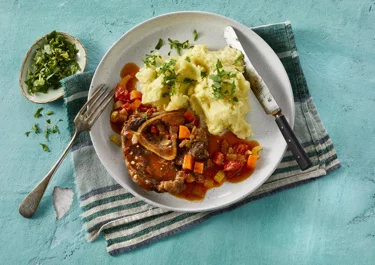Osso buco

Get ready to experience a taste of Italy with the classic dish osso buco! This hearty stew features tender veal shanks that are slow-cooked with a blend of savoury vegetables, white wine, and tomatoes to create a rich and satisfying flavour. With this delicious recipe for osso buco in your repertoire, you will be able to bring a taste of Italy to your own kitchen. Enjoy it with a creamy potato mash and a green garnish of gremolata.
Ingredients
Osso buco
|
Veal shank
|
4 slices |
|---|---|
|
Wheat flour
|
60 g |
|
Fine salt
|
2 tbsp |
|
Freshly ground pepper
|
|
|
Butter
|
25 g |
|
Peeled carrots in large cubes (approx. 350 g)
|
4 |
|
Large, coarsely chopped yellow onions (approx. 200 g)
|
2 |
|
Celery stalks in slices
|
5 |
|
Large, finely chopped garlic cloves
|
3 |
|
Concentrated tomato purée
|
3 tbsp |
|
Dry white wine, for example, Riesling
|
200 ml |
|
Peeled tomatoes
|
1 can |
|
Beef or veal broth
|
500 ml |
Gremolata
|
Coarsely chopped flat-leaf parsley
|
4 tbsp |
|---|---|
|
Finely grated lemon zest (unsprayed)
|
1 tbsp |
|
Small, finely chopped garlic cloves
|
2 |
For serving
|
Mashed potatoes
|
|---|
Instructions
Osso buco
Gremolata
Recommended information
Serving suggestion
Tips
When making osso buco, it is important to use the right cut of veal. The dish traditionally uses veal shanks, which are cut from the leg and contain a bone with marrow. These shanks add richness and depth to the dish, as well as a luxurious texture.
Tips
The meat is done cooking when it is tender and falls off the bone. This can take up to 2-2½ hours, depending on the size of the veal shanks and the cooking method. A good way to test if the meat is done is to pierce it with a fork or knife. If it easily separates from the bone, it is ready.
Tips
Another tip is to take your time with the cooking process. The stew benefits from slow cooking, which allows the flavours to develop and infuse the meat. Be patient and resist the urge to rush the process, as it will only result in tougher meat and less flavour.
Questions about osso buco
This osso buco recipe is just what you need for a hearty meal, bringing everything you love in stews into one irresistible recipe. Read below to learn more about the classic Italian stew.
What is osso buco?
Osso buco is a traditional Italian stew consisting of braised veal shanks cooked in a sauce of mixed vegetables, white wine, and broth. The braised osso buco stew gets its name from the Italian phrase ‘osso buco’, meaning ‘bone with a hole’. This refers to the fact that it is made using veal shanks that contain bone marrow in the centre, which is an essential part of the stew's flavour. Osso buco is typically served with gremolata, a mixture of parsley, garlic, and lemon zest, and is often accompanied by risotto, potato mash, or polenta.
How to make osso buco?
Start by making 3-4 cuts into the edge of each meat slice. Then mix flour, salt, and pepper, and brown the meat in butter in a sauté pan. Remove the meat and brown the carrots, onions, celery, and garlic, and add tomato purée. Place the meat on top of the vegetables, pour in the wine, and let it cook down for 10 minutes. Cover with peeled tomatoes and veal broth, simmer for a couple of hours, and season to taste.
How long does osso buco take to cook?
Osso buco typically takes around 1½ to 2 hours to cook. After browning the meat and vegetables, it is covered with peeled tomatoes and veal broth, brought to a boil, and then simmered over low heat with a lid on for around 1½ hours. After that, the lid is removed, and the stew is simmered for another 30 minutes over high heat to reduce the liquid and thicken the sauce. The total cooking time may vary depending on the size of the veal shanks used and the heat level of the stove.
What to serve with osso buco?
The ideal accompaniments for osso buco are potato mash and gremolata. The rich and savoury flavours of the stew pair well with the creamy texture of mashed potatoes. Gremolata, which is a mixture of parsley, garlic, and lemon zest, adds a fresh and zesty flavour, which complements the richness of the meat and sauce.
What cut of meat is osso buco?
Osso buco is typically made using veal shanks, which are cross-cut sections of the calf's leg. These shanks are cut into thick slices, typically around 3-4 cm thick, which contain a bone with marrow in the centre. The bone marrow is an essential part of adding flavour and is one of the reasons why osso buco is so rich and flavourful. While veal shanks are the traditional cut of meat used in osso buco, some recipes may also use beef or pork shanks as a substitute.
Veal osso buco – slow-cooked stew with warm and hearty flavours
Veal osso buco is a stew that has been enjoyed in Italy for generations. Veal shanks are a cut of meat that is particularly well-suited for slow cooking, as the collagen in the meat breaks down over time, resulting in a tender and flavourful dish. In addition to the veal shanks, the dish typically includes a variety of savoury vegetables, such as carrots, onions, and celery, which are sautéed and then braised along with the meat. The slow cooking process allows the flavours to develop and infuse into the meat, resulting in a flavourful and delicious stew.
Savoury vegetables, white wine, and tomatoes for depth
The savoury vegetables, white wine, and tomatoes are essential components that add depth and richness to the stew. The vegetables, which consist of onions, carrots, garlic, and celery, are sautéed until golden brown, releasing their natural sweetness and developing their flavour. The addition of white wine helps create a flavourful broth by cooking down and reducing, allowing the wine to seep into the vegetables and meat, producing an aromatic and flavourful sauce. The tomatoes provide a tart and tangy flavour to balance the stew’s richness, adding brightness and acidity. When combined, these ingredients work in harmony to create a delicious and complex flavour profile that is a hallmark of the osso buco.
Serve osso buco with gremolata and potato mash
Gremolata and potato mash are classic accompaniments to rich and flavourful osso buco. Gremolata is a mixture of coarsely chopped parsley, garlic, and lemon zest, which provides a bright and zesty contrast to the richness of the meat and sauce. The fresh, citrusy notes of the lemon zest add a burst of flavour that cuts through the rich meat, while the garlic adds a pungent and savoury depth. When combined with the freshness of the parsley, the gremolata provides a delicious balance to the stew’s flavours.
Potato mash, on the other hand, provides a creamy and fluffy texture that pairs perfectly with the tender and fall-off-the-bone meat of the osso buco. The mashed potatoes are an excellent vehicle for soaking up the delicious sauce, creating a perfect balance of flavours and textures. The creamy and buttery notes are a comforting and satisfying complement to the rich and savoury meat dish.
Traditional Italian flavours and bright, enticing colours
The bright and enticing colours of osso buco are a testament to the traditional Italian flavours that are at the heart of the recipe. The stew features the colours of the Italian flag with its red tomato-flavoured sauce/juices, white potato mash, and green gremolata, representing Italian pride in their culinary heritage. The vibrant colours complement the rich flavours, creating an appetising and alluring stew that will entice and satisfy your taste buds. While gremolata is not strictly necessary to enjoy osso buco, it is a classic accompaniment that is widely used in traditional Italian cuisine and is considered by many to be an essential part of the dish.
If you are looking to delve into the world of Italian cuisine, you do not want to miss these mouth-watering recipes. For a fresh and flavourful starter, try bruschetta with ripe tomatoes, garlic, and basil. And for a sweet and indulgent dessert, panna cotta with a berry coulis is sure to hit the spot. If you are looking for more sides to serve with your osso buco, you should try serving it with fried polenta.
Add your own touch to a classic
While osso buco is a traditional recipe, there is always room for a personal touch. You can add a little twist to the recipe by experimenting with different vegetables, such as adding fennel, mushrooms, or even artichokes to the dish. You can also try using different herbs, like rosemary, thyme, or oregano to enhance the flavour. Adding a hint of chilli or red pepper flakes can also add a spicy kick and give it a little bit of heat. If you prefer a sweeter flavour, you can use red wine instead of white wine.









